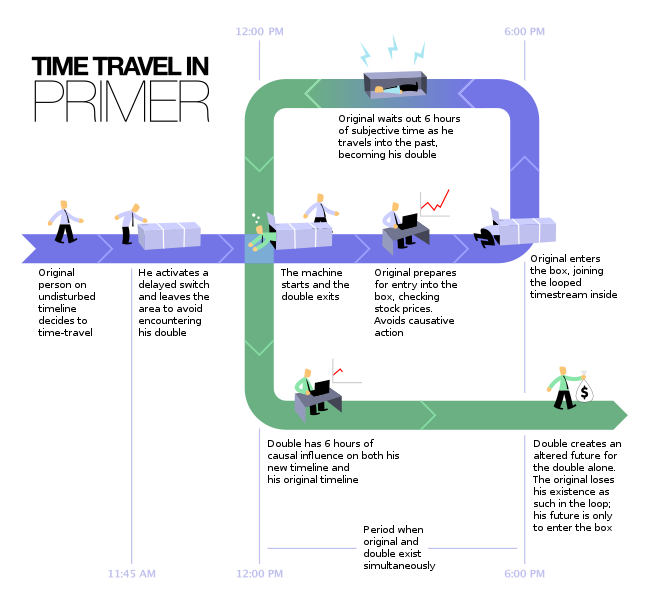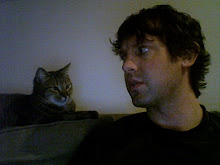
Primer caught my eye when it was released quietly on DVD in 2004. I didn't read the premise on the back of the box and I didn't recognize either of the actors on the front cover. What pulled me in aside from the Sundance Grand Jury award was mostly the tagline. "What Happens if it Actually Works?" Intriguing to say the least. If WHAT actually works, I wondered? I took the 77 minute super-independent film home and my mind proceeded to implode in on itself.
As it turned out, Primer is about time-travel, though not in the easy to follow terms of, say, Back to the Future or The Terminator series. The two lead characters, Aaron (played by producer, writer and director Shane Carruth) and Abe (played by David Sullivan in a noteworthy performance) run a small time software business out of Aaron's garage. While attempting to produce a superconductor the two friends accidentally create a low grade, small scale time machine. The physics are a bit complex, but go something like so. This isn't a simple temporal jaunt, not as simple as flipping a switch or getting the Delorean up to 88 mph. One can only go backwards in time, and you are only able to go back as much time as you're willing to spend the real time in the machine, which is displayed as an aluminum lined makeshift coffin.
Once inside the machine, time moves in a loop from the point in time when it is turned on. If you turn the machine on at noon and set it for 6 hours, inside the machine once it reaches 6pm, time will move backwards to noon again. This is described as A-in, B-out. Therein, if one enters at the B point in time, after staying in the machine 6 hours they will emerge at the A point, having traveled 6 hours back in time. Confused yet? Good.
Needless to say, Aaron and Abe's first attempts to play the stock market need meticulous planning and preparation, ensuring that no outside interference will take place and the possibility of running into their future selves is out of the question.
The first 40 minutes or so is relatively easy to follow, aside from the technical physics laden dialog (Carruth refused to simplify the script for the sake of the audience, to better execute his vision) though shortly after the halfway point, the film turns on its ear and takes a sharp right into massively confusing territory. As the friends become more unwound by stress, lack of sleep (referenced by a line regarding "working 36 hour days") and the adverse affects of continued use of backward time travel, the trust between Abe and Aaron deteriorates. Their reality becomes unhinged as paradoxes begin to pile on top of each other. So many details are scattered about, conveyed through a hauntingly cryptic voice over from an answering machine message that at this point, the film demands your complete attention. Even then, it is likely some detail will be missed.
Through simple cinematography and a hauntingly simplistic score, the latter half of the film plays almost like a psychological film noir. Who's playing against who. What is really to be gained from all of this. What actually went wrong in the first place. The film almost demands multiple viewings to put it's abstract puzzle pieces together. Still, the final product may indeed be incomprehensible, which is to say, the human mind cannot yet comprehend the cataclysmic effects of time travel.
For a production budget of only $7000 the effectiveness of this film is astounding. No A-list stars or name recognition, extremely limited effects and a limited amount of locations. The story is what drives this film to success, whether it's understood by the viewer or not. It may take several days to untangle the knot it will make of your brain functions, but at a 77 minute run time the end result is well worth it.
For those still confused by my feeble attempt to explain the physics of Primer's time travel, here's a handy diagram:
 Still can't read it? Click to ReBigulate!
Still can't read it? Click to ReBigulate!
 Still can't read it? Click to ReBigulate!
Still can't read it? Click to ReBigulate!







No comments:
Post a Comment